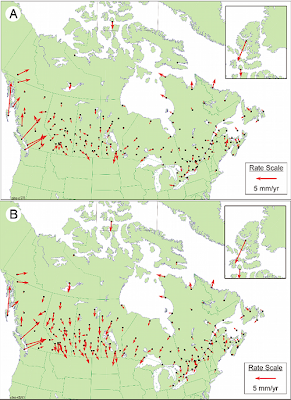In 2003, a group of scientists was established to determine the stable North America reference frame (SNARF). They aimed to define a regional reference frame that is consistent and stable at the level of sub-mm yr-1 across North America (Henton et al., 2006). The SNARF vertical datum is consistent with ITRF2000 in a way that centre of mass of the whole Earth system is taken to be the origin, while the horizontal datum differs by a rotation rate that brings the rotation of the stable part of North America to rest.

|
Figure 1: Residual horizontal intra-plate velocities of CBN using North American plate motion estimates (rotations) from (A) ITRF2000, and from (B) SNARF 1.0 (from Henton et al. 2006) |
Blewitt et al. (2005) have compared horizontal intra-plate velocities of the Canadian base network (CBN) using North American plate motion estimates (rotations) from ITRF2000 and SNARF 1.0. Horizontal intra-plate velocities in SNARF show a pattern that is more consistent with expected deformations from GIA than velocities obtained from ITRF2000. The plate motion estimate absorbs much of horizontal motion from GIA that is expected to spread outward from the areas of maximum uplift (Figure 1A). But in the plate motion estimates defined in SNARF, the outward pattern of intra-plate velocities is more clearly visible (Figure 1B).
References
Blewitt, G., Argus, D. F., Bennett, R. A., Bock, Y., Calais, E., Craymer, M. R., Davis, J. L., et al. (2005). A stable North America reference frame (SNARF): First release. UNAVCO-IRIS Joint Workshop Proceedings: Stevenson. Washington, USA.
Henton, J. A., Raymer, M. R., Ferland, R., Dragert, H., Mazzotti, S., and Forbes, D. L. (2006). Crustal motion and deformation monitoring of the Canadian landmass. Geomatica, 60(2), 173-191.
No comments:
Post a Comment